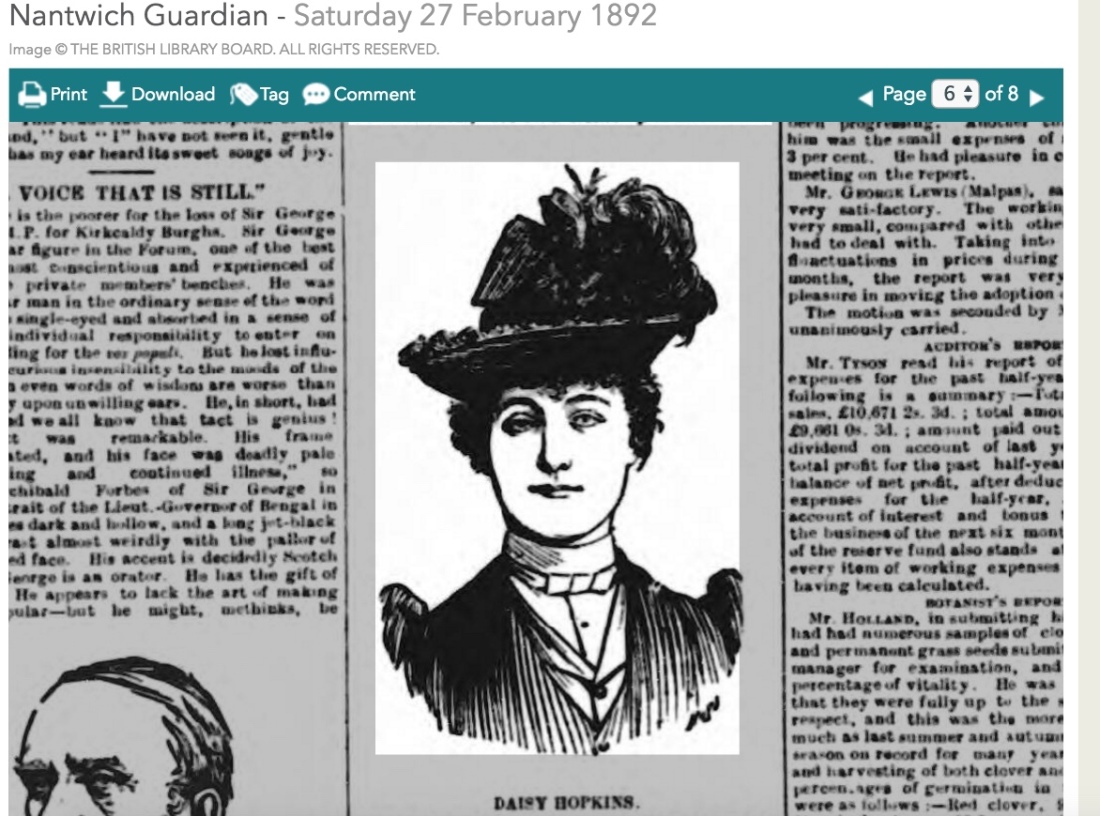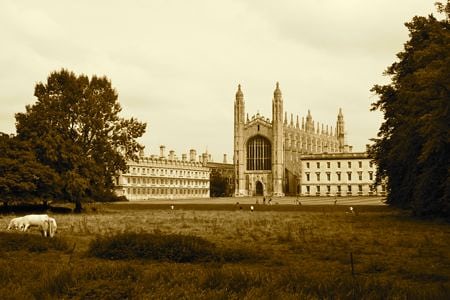Daisy Hopkins:

On a cold night, December 4th of 1891, Daisy Hopkins was returning from visiting a friend in Newnham when a young man, presumably an undergraduate of Cambridge University, stopped her near the campus to ask the way to Tennis Court Road. According to a news article from the Huddersfield Chronicle dated Friday, March 25, 1892, seventeen-year-old Daisy Hopkins of Cambridge, a young dressmaker living at home with her parents, was stopped and questioned after she’d been seen talking to a younger man. The report states that after walking 300 yards, Daisy was stopped by the Proctor’s man, Constable Alfred Kirby. He came up to her, took hold of her dress and “tore it from the gathers” (4). She was forced against her will to remain for questioning. After the Proctor arrived, he took one look at Daisy and said, “There’s not the least doubt about it.” Daisy was taken to the Spinning House to be falsely imprisoned for fourteen days based on the University’s accusations. She was released after ten days. Due to citizen’s outrage and Daisy’s lawsuit, the legislation governing Cambridge University Proctors was amended and no longer allowed them to partner with police and arrest women for prostitution on mere suspicion. This change only occurred after Daisy had endured months of humiliation that damaged her character and even an affecting impersonation from a stranger. It’s this impersonation that sets us down the path towards the legitimacy of fallenness and the constitution of “Fallen Woman.”
“The Imprisonment of Daisy Hopkins,” The Evening Press, 1892
 Photo credit: https://lostcambridge.wordpress.com/women_of_cambridge/
Photo credit: https://lostcambridge.wordpress.com/women_of_cambridge/
Daisy’s Arrest
“The Cambridge Spinning House”, Huddersfield Chronicle, 1892


(https://www.proctors.cam.ac.uk/directory/constabulary) https://www.proctors.cam.ac.uk/directory/past-proctors (The Cambridge Proctor in 1891 was Alfred Caldecott)
https://www.proctors.cam.ac.uk/directory/past-proctors (The Cambridge Proctor in 1891 was Alfred Caldecott)
The Chapel at King’s College, Cambridge, otherwise known as “the backs.” Women seen talking to undergraduates in this area could be arrested by Proctors
(https://www.theguardian.com/science/the-h-word/2012/oct/19/history-science)
“Daisy Hopkins’ Action” Gloucester Journal, 1892


The passing of the Contagious Diseases Acts created a measure of anxiety for middle to upper-class Victorian society. The premise for the CDA was to regulate the spread of diseases, such as syphilis and gonorrhea, by emphasizing notions that diseases could be hidden in even the most beautiful and delicate female creatures. Due to this information, the CDA came with a price. In her essay, “The Constitution Violated,” Josephine Butler wrote, “The malicious whisper of a single man, under the Contagious Diseases Acts, may destroy the character of a woman” (78). Butler argued that under the Acts, there was no clear definition for discerning between a woman walking home from work at night and an actual prostitute. The idiocy and violation of the CDA Butler is calling attention to presupposes “that every woman who is found associating, under any circumstances, with a man, and who cannot produce a certificate of her marriage with him, is to be called a prostitute under the Acts” (92-93).
For Daisy, there was more drama to unfold, witnesses to procure, and money to be paid. Over a century later, the reality of these events, which underscore Victorian class-normatives, read in juxtaposition to sociocultural literature from the nineteenth century. Take for instance Elizabeth Gaskell’s Ruth. Gaskell uses her characters to demonstrate how Victorian society aids and perpetuates fallenness. Just as Daisy’s short conversation with a young man was completely innocent, so were Gaskell’s protagonist, Ruth’s outings through the country with Henry Bellingham. Unfortunately, both women were indicted, and presumed “fallen” by authority figures before they could speak in their defense; Although, the truth of the matter is that women had little opportunity to speak out for themselves, but they had plenty of time to suffer in silence.
In reality, Daisy Hopkins subverted the “Fallen Woman” ideology and sued the institution that used legislation to mar her reputation. In Gaskell’s novel, Ruth chose to ostracize herself from marital governance to become an idealized version of the Angel in the House. But what about Jane Elsdon; The second Daisy, the fake Daisy? This young woman—a milliner—who supposedly stepped off of a train and innocently into the arms of drunkenness, whose release from Holloway prison was paid for by an unknown person on the same day of her arrest, and who, by officer’s accounts reported in Lloyd’s Weekly London Newspaper, was so outrageous in her behavior that she “nearly tore her skirts off” (4) is a fallen woman. She is the epitome of the Victorian class-based, eco-pandering stereotype. She has been seen in a way that society has fixed irredeemable.
Daisy was vindicated by public outcry, even though she lost her lawsuit against the Rev. F Wallis, Pro-Proctor of Cambridge University for unlawful detainment. Ruth, a fictitious character, was redeemed by her virtuous, noble death. Jane…well, Jane Elsdon was released by an “unknown.” ˜
Jane Elsdon:
“Daisy Hopkins” Lloyd’s Weekly London Newspaper, Feb. 21, 1892, p.4
“A young woman giving the name of Daisy Hopkins, 18, a milliner at Cambridge, was charged before the Lord Mayor, at the Mansion house on Wednesday, with being drunk and disorderly and using obscene language in Gracechurch-street, and assaulting the police. Police-constable John Lewis, 852, said on Tuesday evening, about 12 minutes past seven, he was in Gracechurch-street, and saw the prisoner with a large crowd round her. He requested her to go away. She declined to do so, and struck several boys who were standing round. She said she would not go away, would be locked up. She went away a short distance, and then got a crowd round her again. Seeing that she would not go away he took her into custody. She was drunk. On the way to the station she was violent, and another policeman had to be called to help him. She used very filthy language. She also kicked out violently, and nearly tore her skirts off. He was obliged to hold her dress up to prevent her becoming naked in the street. She gave the name of Daisy Hopkins, and said she came from Cambridge. That morning she said she had been locked up at Cambridge and was bringing an action against one of the members of Cambridge university for false imprisonment, claiming 1,000s in damages. The prisoner put no questions to the police.—Harry Dungess, another officer, said he was called to assist the last witness. The prisoner was very violent, and was charging and kicking at the crowd. On the way to the station she struck him three times on the face with her right hand. She was drunk. Her language was very bad. The prisoner, being asked by the Lord Mayor what she had to say, said (crying): “I am very sorry. I came up from Cambridge by an afternoon train, and was got hold of by some woman, who made me drunk, and not knowing London, I lost my way.” The Lord Mayor fined her 20s., or seven days’ imprisonment.—The prisoner said she knew no one in London and had not the money. On the same evening, however, she was discharged from Holloway prison, the fine being paid by a person unknown. The friends of Daisy Hopkins deny she was the person who was brought up at the Mansion house, and assert that there has been personation. The clerk to her solicitor had an interview with her at her home on Wednesday afternoon, when also a police-officer called and saw her, and another policeman observed her in Cambridge in the evening. In answer to inquiries on Thursday at the Seething-lane police-station it was stated that on the night she was taken into custody the woman gave her name as Jane Elsdon, and stated that she had been in the Spinning house. Jane Elsdon is well known in Cambridge as having escaped from the Spinning house” (pg 4).
“Daisy Hopkins.” Lloyd’s Weekly London Newspaper, 1892

The Spinning House became a prison house for confining and whipping women. http://www.workhouses.org.uk/Cambridge/
So who is Jane Elsdon? She’s not Daisy Hopkins. If we consider the article’s description and evaluation of the girl, she’s a reprobate: a drunkard, a drifter, uncouth, bawdy, deceitful, violent, and fallen. It seems as though she’s ripped right out of one of the pages of Henry Mayhew’s London Labour and the London Poor (circa 1851). “…when an innocent child appears in the streets without a protector, she is insidiously watched … no sooner is the unsuspecting one within their grasp…she becomes a victim to their inhuman designs” (Mayhew, 475). It’s a mystery thus far what happened to Jane later in life. If she was telling the truth, and she literally stepped off a train from Cambridge to London, into the arms of an unknown woman who got her drunk and left her defenseless (she, obviously knowing the story of Daisy Hopkins since she pretended to be her), then it’s safe to say that the Victorian Fallen Woman narrative is a trope carved from the news headlines. Literally.


After coming across the story of Daisy Hopkins, it was by happy accident that I ran into Jane Elsdon. I’m thankful that I did. Had I not been able to peruse these historical newspaper articles, I would have confused the two women to be one and the same, without ever knowing their stories. For additional information on Gloucester Journal, Huddersfield Chronicle, Lloyd’s Weekly Newspaper, The Evening Press, and The Yorkshire Evening Post, please visit these links:
https://huddersfield.exposed/wiki/Huddersfield_Chronicle
http://www.bramstoker.org/publishers/lloyds.html (LWN)
https://www.yorkshireeveningpost.co.uk/ (Still in circulation)
BIBLIOGRAPHY
- Butler, Josephine. “The Constitution Violated.” Michigan UP, 2018. (Originally published in 1871.)
- “Daisy Hopkins’ Action.” Gloucester Journal, 26 March 1892. p.8. Newspaper. The British Newspaper Archive, www.britishnewspaperarchive.co.uk/viewer/bl/0000532/18920326/169/0008
- Gaskell, Mary. Ruth. Penguin Books, 1997.
- Mayhew, Henry. London Labour and the London Poor. 1985.
- “The Cambridge Spinning House.” Huddersfield Chronicle, 25 March 1892. p.4. Newspaper. The British Newspaper Archive, https://www.britishnewspaperarchive.co.uk/viewer/bl/0000167/18920325/020/0004?noTouch=true
- “The Imprisonment of Daisy Hopkins.” The Evening Press, 6 January 1892. p.4. Newspaper. The British Newspaper Archive, https://www.proctors.cam.ac.uk/directory/constabulary
- “The Reported Conviction of Daisy Hopkins.” The Yorkshire Evening Post, 18 February 1892. p.4. Newspaper. The British Newspaper Archive,
GLOSSARY
Milliner
mil·li·ner [ˈmilənər] noun: a person who makes or sells women’s hats.
Proctor
proc·tor [ˈpräktər] noun: (North American) a person who monitors students during an examination.(British ) an officer (usually one of two) at certain universities, appointed annually and having mainly disciplinary functions.
LINKS
- www.britishnewspaperarchive.co.uk/viewer/bl/0000532/18920326/169/0008
- https://www.britishnewspaperarchive.co.uk/
- https://www.theguardian.com/science/the-h-word/2012/oct/19/history-science
- http://www.workhouses.org.uk/Cambridge/
- https://www.proctors.cam.ac.uk/directory/constabulary
- https://lostcambridge.wordpress.com/women_of_cambridge/
- https://english637fallenwoman.files.wordpress.com/2018/03/the-reported-conviction-of-daisy-hopkins-a-correction-and-explanation.pdf
- https://english637fallenwoman.files.wordpress.com/2018/03/news-story-of-jane-elsdon-pretending-to-be-daisy.pdf
- https://english637fallenwoman.files.wordpress.com/2018/03/the-cambridge-spinning-house-huddersfield-chronicle.pdf
- https://www.geog.cam.ac.uk/people/howell/

Your comments on Josephine Butler and the CDA are accurate. Perhaps it would be useful to clarify that the ‘contagious diseases’ were actually syphilis and gonorrhoea. Can I make a plea for historical dating in your Bibliography? For example, The Constitution Violated may have been republished in 2018, but it was originally published in 1871. So it seems important to give that date as well.
Helen Mathers, author of Patron Saint of Prostitutes. Josephine Butler and a Victorian Scandal (History Press, 2014) josephinebutlerpage.com
LikeLike
josephinebutlerpage,
I just came across your comment from months ago, and I thank you for pointing those things out. I have updated that information (among a few other things) for clarification. I look forward to reading some of Ellen Buckingham Mathews (AKA Helen Mathers) books. Perhaps one can help me with my thesis.
Best regards,
L. R. Six
LikeLike
Hi Leticia,
Thanks for this response. My book about Josephine Butler is called Patron Saint of Prostitutes. An ebook version is available from Amazon.
Incidentally, I don’t have another name! Only Helen Mathers.
Best wishes,
Helen
LikeLike